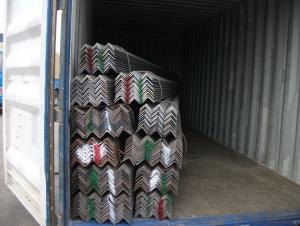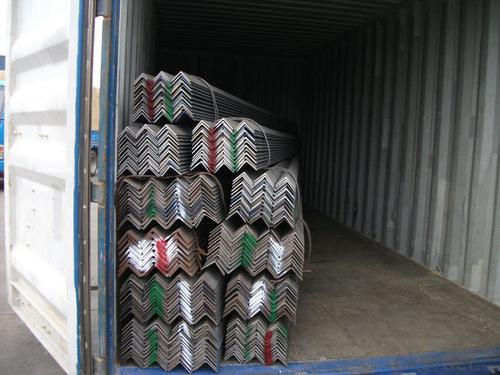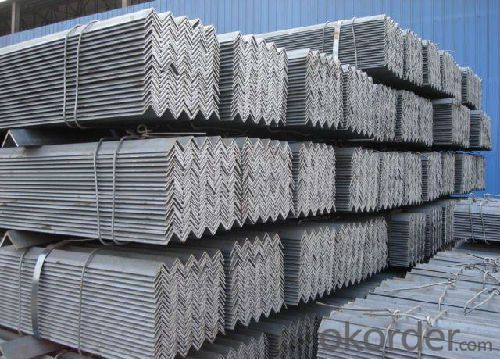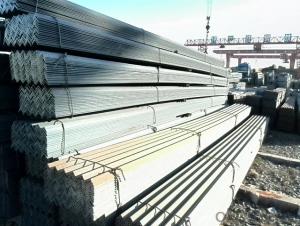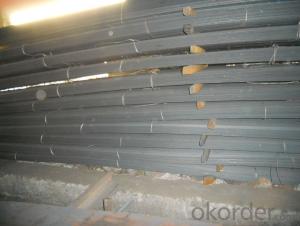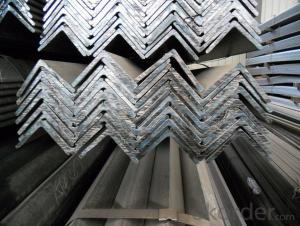Hot Rolled Equal Angle steel with grade A quality
- Loading Port:
- Tianjin
- Payment Terms:
- TT OR LC
- Min Order Qty:
- 25 m.t.
- Supply Capability:
- 10000 m.t./month
OKorder Service Pledge
OKorder Financial Service
You Might Also Like
Specification
OKorder is offering high quality Hot Rolled Steel Angle at great prices with worldwide shipping. Our supplier is a world-class manufacturer of steel, with our products utilized the world over. OKorder annually supplies products to European, North American and Asian markets. We provide quotations within 24 hours of receiving an inquiry and guarantee competitive prices.
Product Applications:
Hot Rolled Steel Angle are ideal for structural applications and are widely used in the construction of buildings and bridges, and the manufacturing, petrochemical, and transportation industries.
Product Advantages:
OKorder's Steel Angle are durable, strong, and resist corrosion.
Main Product Features:
· Premium quality
· Prompt delivery & seaworthy packing (30 days after receiving deposit)
· Corrosion resistance
· Can be recycled and reused
· Mill test certification
· Professional Service
· Competitive pricing
Product Specifications:
Manufacture: Hot rolled
Grade: Q195 – 235
Certificates: ISO, SGS, BV, CIQ
Length: 6m – 12m, as per customer request
Packaging: Export packing, nude packing, bundled
Sizes: 25mm-250mm | ||
a*t | ||
25*2.5-4.0 | 70*6.0-9.0 | 130*9.0-15 |
30*2.5-6.6 | 75*6.0-9.0 | 140*10-14 |
36*3.0-5.0 | 80*5.0-10 | 150*10-20 |
38*2.3-6.0 | 90*7.0-10 | 160*10-16 |
40*3.0-5.0 | 100*6.0-12 | 175*12-15 |
45*4.0-6.0 | 110*8.0-10 | 180*12-18 |
50*4.0-6.0 | 120*6.0-15 | 200*14-25 |
60*4.0-8.0 | 125*8.0-14 | 250*25 |
FAQ:
Q1: Why buy Materials & Equipment from OKorder.com?
A1: All products offered byOKorder.com are carefully selected from China's most reliable manufacturing enterprises. Through its ISO certifications, OKorder.com adheres to the highest standards and a commitment to supply chain safety and customer satisfaction.
Q2: How do we guarantee the quality of our products?
A2: We have established an advanced quality management system which conducts strict quality tests at every step, from raw materials to the final product. At the same time, we provide extensive follow-up service assurances as required.
Q3: How soon can we receive the product after purchase?
A3: Within three days of placing an order, we will begin production. The specific shipping date is dependent upon international and government factors, but is typically 7 to 10 workdays.
Images:
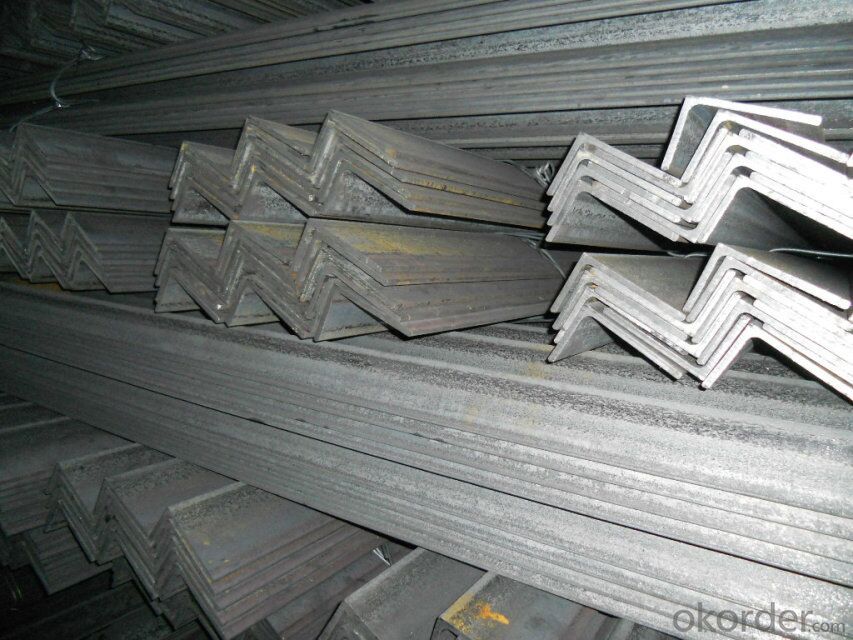
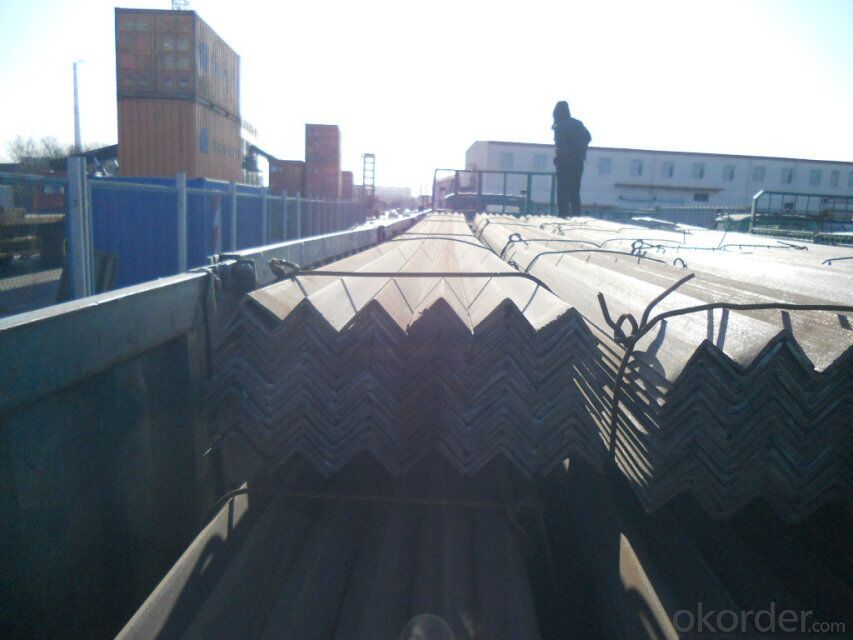
- Q: Can steel angles be used in seismic or high-wind areas?
- Yes, steel angles can be used in seismic or high-wind areas. Steel angles are commonly used in construction for their strength and durability. They provide structural support and can withstand seismic forces and high winds when properly designed and installed. The use of steel angles in these areas is often subject to specific building codes and regulations, which ensure that the structures are capable of withstanding the forces generated by earthquakes or strong winds. Engineering analysis and design considerations must be taken into account to ensure the appropriate size, configuration, and connection details of the steel angles in order to meet the required safety standards.
- Q: Can steel angles be used as supports for suspended acoustical ceilings?
- Yes, steel angles can be used as supports for suspended acoustical ceilings. Steel angles are often used as a main structural component in suspended ceiling systems. They provide stability and support for the acoustical ceiling tiles and help distribute the weight evenly across the ceiling grid. The steel angles are typically installed at regular intervals along the perimeter of the ceiling and are connected to the main suspension system. This ensures that the acoustical ceiling remains securely in place and can effectively absorb sound and improve the overall acoustics of the space.
- Q: Can steel angles be used for manufacturing outdoor benches?
- Yes, steel angles can be used for manufacturing outdoor benches. Steel angles provide strength, durability, and stability, making them suitable for outdoor use. Additionally, steel angles can withstand weather elements such as rain, sun exposure, and temperature changes, ensuring the longevity of the outdoor benches.
- Q: How do steel angles perform in high-temperature environments?
- Steel angles perform well in high-temperature environments due to their high melting point and excellent heat resistance. They retain their structural integrity and strength, making them a suitable choice for applications that require stability and durability in elevated temperatures.
- Q: What is the maximum allowable lateral torsional buckling stress for a steel angle?
- The maximum stress that a steel angle can withstand before lateral torsional buckling occurs depends on several factors, including the angle's size, shape, material properties, and the design code being followed. To determine the maximum allowable stress for a steel angle, one can consider the critical moment of inertia and its corresponding critical stress. The critical moment of inertia measures the angle's ability to resist lateral torsional buckling and is affected by its geometry and dimensions. Design codes such as the AISC Manual of Steel Construction or the Eurocode provide specific values for the maximum allowable lateral torsional buckling stress. These codes offer guidelines and formulas for calculating this stress based on the angle's dimensions, material properties, and other factors like effective length and end conditions. To accurately determine the maximum allowable lateral torsional buckling stress for a particular steel angle, it is crucial to refer to the appropriate design code or standard and seek advice from a structural engineer or consult relevant reference materials.
- Q: Can steel angles be used for framing windows or doors?
- Yes, steel angles can be used for framing windows or doors. They provide structural support and stability, making them a suitable choice for framing openings in buildings.
- Q: How do you calculate the weight of a steel angle?
- To calculate the weight of a steel angle, you need to know the dimensions of the angle, such as the length, width, and thickness. Then, you can use the formula: weight = (length × width × thickness) × density of steel. The density of steel is typically around 7.85 grams per cubic centimeter.
- Q: Can steel angles be used for staircases?
- Yes, steel angles can be used for staircases. Steel angles are commonly used in construction for their strength and durability. When it comes to staircases, steel angles are often used as stringers or support beams to provide structural stability. They can be used to create the framework or skeleton of the staircase, supporting the steps and providing a sturdy structure for people to walk on. Steel angles are versatile and can be easily customized and fabricated to meet specific design requirements for staircases. Additionally, steel angles are resistant to corrosion, making them suitable for both indoor and outdoor staircases.
- Q: What are the different types of steel angles used in machinery?
- There are several different types of steel angles that are commonly used in machinery. One of the most common types is the equal-leg angle, also known as L-shaped or L-angle steel. This angle has equal dimensions on both sides, forming a 90-degree angle. It is commonly used in machinery to provide structural support and stability, as well as to reinforce joints and connections. Another type is the unequal-leg angle, which has different dimensions on each side, resulting in an uneven angle. This type of angle is often used in machinery where specific weight distribution or load-bearing requirements need to be met, as it allows for greater flexibility in design. Additionally, there are also rounded steel angles, also known as rounded corner angles or round bars. These angles have rounded edges instead of sharp corners, making them ideal for machinery applications where safety is a concern, as they reduce the risk of injury from sharp edges. Furthermore, there are slotted steel angles, which have one or more holes or slots along their length. These slots allow for easy adjustment and mounting of components, making them suitable for machinery that requires frequent modifications or customization. Lastly, stainless steel angles are another type commonly used in machinery. Stainless steel offers excellent corrosion resistance, making it ideal for machinery that operates in harsh or corrosive environments, such as marine or chemical applications. Overall, the choice of steel angle in machinery depends on the specific requirements of the application, including structural needs, load-bearing capacity, safety considerations, and environmental factors.
- Q: What are the different types of steel angles used in storage racks?
- Storage racks commonly utilize various types of steel angles to ensure strength and stability, facilitating efficient storage and organization of items. 1) The most frequently employed steel angle in storage racks is the equal angle. It possesses identical sides and serves as the primary support beam in the rack's structure. The balanced weight distribution and stability it offers make it ideal for this purpose. 2) Unequal angles, as the name implies, have varying side lengths. These angles find application in storage racks that necessitate specific weight distribution or load-bearing requirements. The longer side of the unequal angle provides additional support for heavier items or different storage configurations. 3) Slotted angles are versatile, allowing convenient adjustment and customization of storage rack systems. They feature slots along their length, enabling the addition of shelves, dividers, or other accessories as required. Slotted angles are commonly found in warehouses or industrial settings where frequent reconfiguration of the rack system is necessary. 4) Perforated angles contain holes punctured along their length, offering improved ventilation and visibility for stored items. They are often employed in storage racks for items that require airflow or in retail settings where product visibility holds significance. 5) Corner angles, on the other hand, are L-shaped steel angles used to reinforce and strengthen the corners of storage racks. They provide additional support and stability, preventing the rack from collapsing or tipping over when heavy items are stored on the shelves. Ultimately, the choice of steel angle for storage racks relies on specific requirements such as load-bearing capacity, customization options, ventilation needs, and visual appeal. By selecting the appropriate steel angle, storage racks can be optimized for maximum efficiency and durability.
Send your message to us
Hot Rolled Equal Angle steel with grade A quality
- Loading Port:
- Tianjin
- Payment Terms:
- TT OR LC
- Min Order Qty:
- 25 m.t.
- Supply Capability:
- 10000 m.t./month
OKorder Service Pledge
OKorder Financial Service
Similar products
Hot products
Hot Searches
Related keywords
